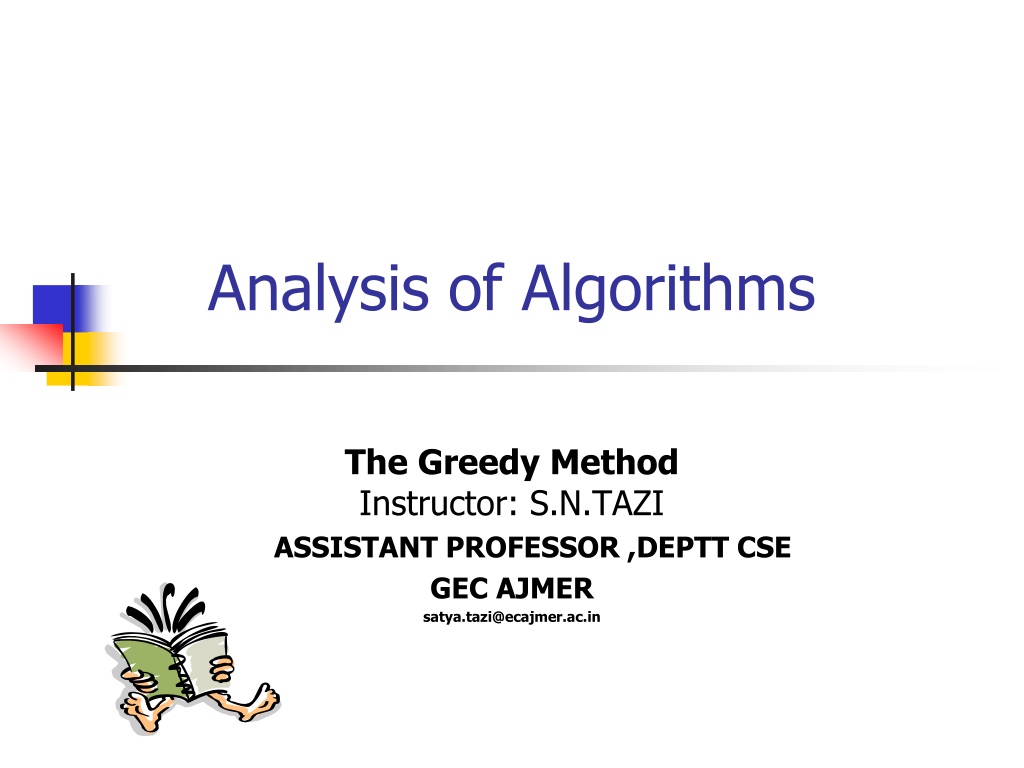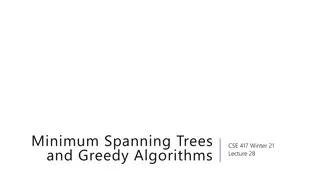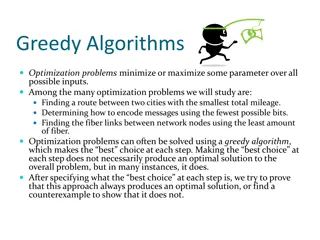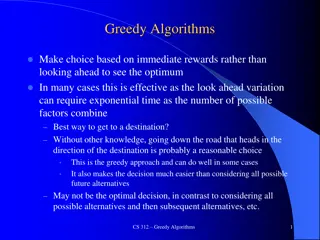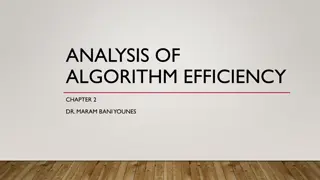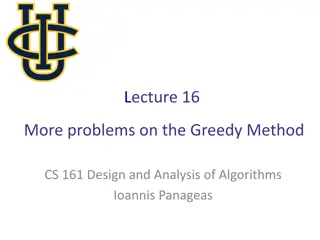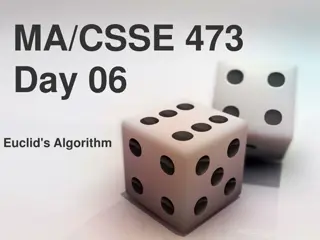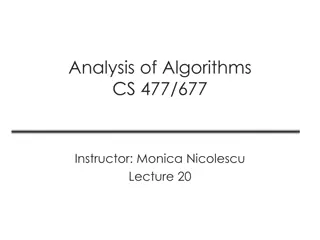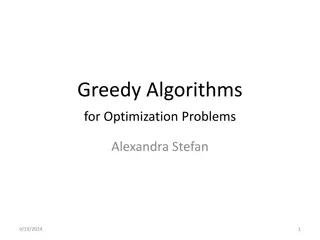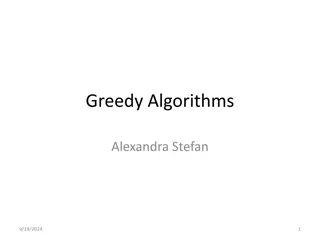Overview of Greedy Method in Algorithm Analysis
The Greedy Method in algorithm analysis involves making locally optimal decisions that eventually lead to a globally optimal solution. This method is illustrated through examples such as finding the shortest paths on special and multi-stage graphs, and solving the activity selection problem. While the Greedy Method is effective for certain optimization problems, it may not always provide the most optimal solution, as demonstrated in the examples provided.
Download Presentation

Please find below an Image/Link to download the presentation.
The content on the website is provided AS IS for your information and personal use only. It may not be sold, licensed, or shared on other websites without obtaining consent from the author.If you encounter any issues during the download, it is possible that the publisher has removed the file from their server.
You are allowed to download the files provided on this website for personal or commercial use, subject to the condition that they are used lawfully. All files are the property of their respective owners.
The content on the website is provided AS IS for your information and personal use only. It may not be sold, licensed, or shared on other websites without obtaining consent from the author.
E N D
Presentation Transcript
Analysis of Algorithms The Greedy Method Instructor: S.N.TAZI ASSISTANT PROFESSOR ,DEPTT CSE GEC AJMER satya.tazi@ecajmer.ac.in
A simple example Problem: Pick k numbers out of n numbers such that the sum of these k numbers is the largest. Algorithm: FOR i = 1 to k pick out the largest number and delete this number from the input. ENDFOR 3 -2
The greedy method Suppose that a problem can be solved by a sequence of decisions. The greedy method has that each decision is locally optimal. These locally optimal solutions will finally add up to a globally optimal solution. Only a few optimization problems can be solved by the greedy method. 3 -3
Shortest paths on a special graph Problem: Find a shortest path from v0 to v3. The greedy method can solve this problem. The shortest path: 1 + 2 + 4 = 7. 3 -4
Shortest paths on a multi-stage graph Problem: Find a shortest path from v0 to v3 in the multi-stage graph. Greedy method: v0v1,2v2,1v3 = 23 Optimal: v0v1,1v2,2v3 = 7 The greedy method does not work. 3 -5
Solution of the above problem dmin(i,j): minimum distance between i and j. 3+dmin(v1,1,v3) 1+dmin(v1,2,v3) 5+dmin(v1,3,v3) 7+dmin(v1,4,v3) dmin(v0,v3)=min This problem can be solved by the dynamic programming method. 3 -6
The activity selection problem Problem: n activities, S = {1, 2, , n}, each activity i has a start time si and a finish time fi, si fi. Activity i occupies time interval [si, fi]. i and j are compatible if si fj or sj fi. The problem is to select a maximum-size set of mutually compatible activities 3 -7
Example: i si fi 1 1 4 2 3 5 3 0 6 4 5 7 5 3 8 6 5 9 7 6 10 8 8 11 9 8 12 10 2 13 11 12 14 The solution set = {1, 4, 8, 11} Algorithm: Step 1: Sort fi into nondecreasing order. After sorting, f1 f2 f3 fn. Step 2: Add the next activity i to the solution set if i is compatible with each in the solution set. Step 3: Stop if all activities are examined. Otherwise, go to step 2. Time complexity: O(nlogn) 3 -8
Solution of the example: i 1 2 3 4 5 7 8 9 10 11 si 1 3 0 5 3 6 8 8 2 12 fi 4 5 6 7 8 10 11 12 13 14 accept Yes No No Yes No No Yes No No Yes Solution = {1, 4, 8, 11} 3 -9
Job sequencing with deadlines Problem: n jobs, S={1, 2, , n}, each job i has a deadline di 0 and a profit pi 0. We need one unit of time to process each job and we can do at most one job each time. We can earn the profit pi if job i is completed by its deadline. i pi di 1 20 2 2 15 2 3 10 1 4 5 3 5 1 3 The optimal solution = {1, 2, 4}. The total profit = 20 + 15 + 5 = 40. 3 -10
Algorithm: Step 1: Sort pi into nonincreasing order. After sorting p1 p2 p3 pn. Step 2: Add the next job i to the solution set if i can be completed by its deadline. Assign i to time slot [r-1, r], where r is the largest integer such that 1 r di and [r-1, r] is free. Step 3: Stop if all jobs are examined. Otherwise, go to step 2. Time complexity: O(n2) 3 -11
e.g. i 1 2 3 4 5 pi 20 15 10 5 1 di 2 2 1 3 3 assign to [1, 2] assign to [0, 1] reject assign to [2, 3] reject solution = {1, 2, 4} total profit = 20 + 15 + 5 = 40 3 -12
The knapsack problem n objects, each with a weight wi > 0 capacity of knapsack: M a profit pi > 0 p x i i Maximize Subject to 0 xi 1, 1 i n 1 i n w x i n 1 M i i 3 -13
The knapsack algorithm The greedy algorithm: Step 1: Sort pi/wi into nonincreasing order. Step 2: Put the objects into the knapsack according to the sorted sequence as possible as we can. e. g. n = 3, M = 20, (p1, p2, p3) = (25, 24, 15) (w1, w2, w3) = (18, 15, 10) Sol: p1/w1 = 25/18 = 1.39 p2/w2 = 24/15 = 1.6 p3/w3 = 15/10 = 1.5 Optimal solution: x1 = 0, x2 = 1, x3 = 1/2 total profit = 24 + 7.5 = 31.5 3 -14
Huffman codes In telecommunication, how do we represent a set of messages, each with an access frequency, by a sequence of 0 s and 1 s? To minimize the transmission and decoding costs, we may use short strings to represent more frequently used messages. This problem can by solved by using an extended binary tree which is used in the 2- way merging problem. 3 -15
An example of Huffman algorithm Symbols: A, B, C, D, E, F, G freq. : 2, 3, 5, 8, 13, 15, 18 Huffman codes: A: 10100 B: 10101 C: 1011 D: 100 E: 00 F: 01 G: 11 A Huffman code Tree 3 -16
